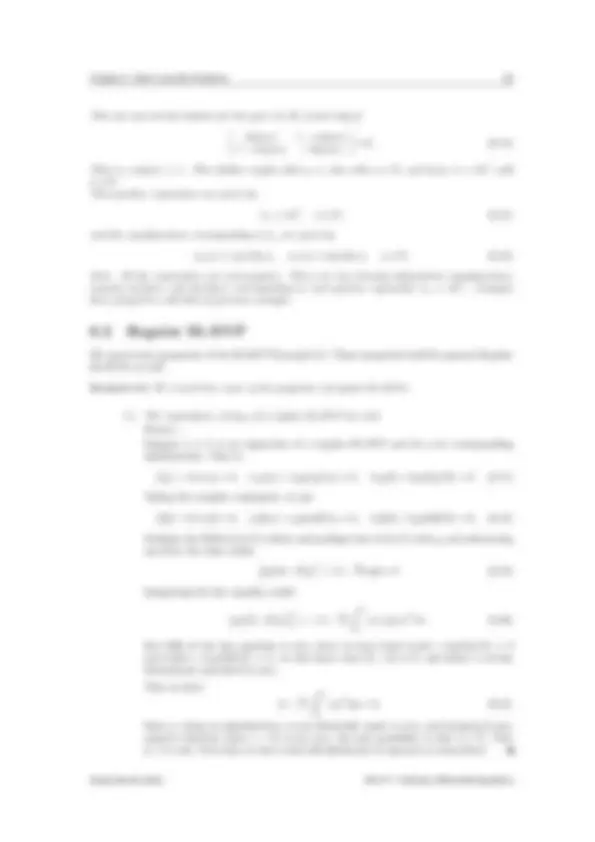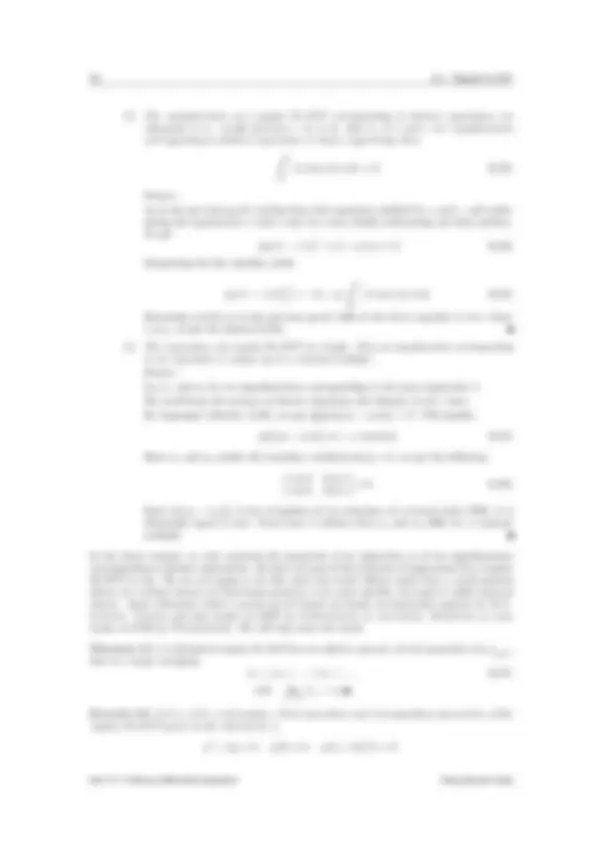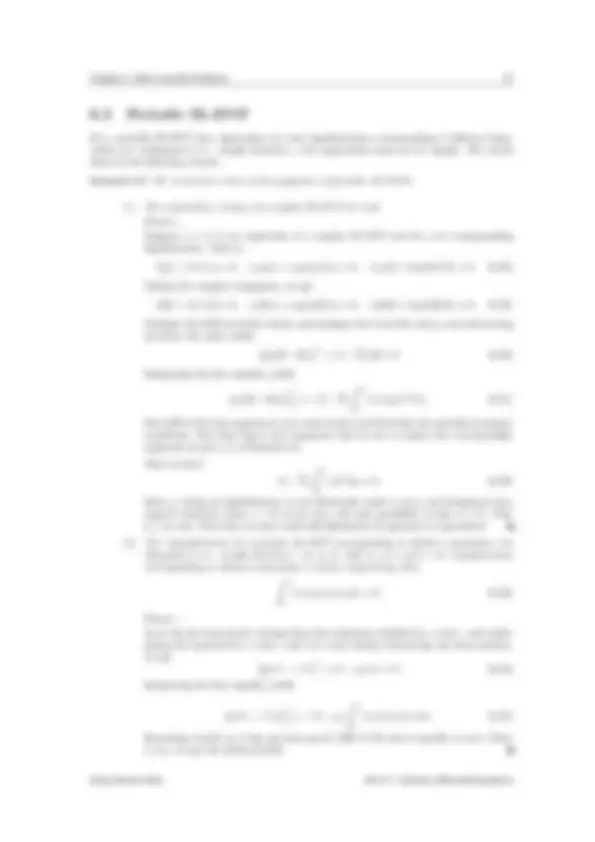





Study with the several resources on Docsity

Earn points by helping other students or get them with a premium plan


Prepare for your exams
Study with the several resources on Docsity

Earn points to download
Earn points by helping other students or get them with a premium plan
Community
Ask the community for help and clear up your study doubts
Discover the best universities in your country according to Docsity users
Free resources
Download our free guides on studying techniques, anxiety management strategies, and thesis advice from Docsity tutors
Sturm-Liouville Boundary Value Problem and Regular SL-BVP are mentioned with examples.
Typology: Lecture notes
1 / 6

This page cannot be seen from the preview
Don't miss anything!




Definition 6.1 (Sturm-Liouville Boundary Value Problem (SL-BVP)) With the notation
L[y] ≡
d dx
p(x)
dy dx
consider the Sturm-Liouville equation
L[y] + λr(x) y = 0, (6.2)
where p > 0 , r ≥ 0 , and p, q, r are continuous functions on interval [a, b]; along with the boundary conditions a 1 y(a) + a 2 p(a)y′(a) = 0, b 1 y(b) + b 2 p(b)y′(b) = 0, (6.3) where a^21 + a^22 6 = 0 and b^21 + b^22 6 = 0.
The problem of finding a complex number μ if any, such that the BVP (6.2)-(6.3) with λ = μ, has a non-trivial solution is called a Sturm-Liouville Eigen Value Problem (SL-EVP). Such a value μ is called an eigenvalue and the corresponding non-trivial solutions y(.; μ) are called eigenfunctions. Further, (i) An SL-EVP is called a regular SL-EVP if p > 0 and r > 0 on [a, b]. (ii) An SL-EVP is called a singular SL-EVP if (i) p > 0 on (a, b) and p(a) = 0 = p(b), and (ii) r ≥ 0 on [a, b].
(iii) If p(a) = p(b), p > 0 and r > 0 on [a, b], p, q, r are continuous functions on [a, b], then solving Sturm-Liouville equation (6.2) coupled with boundary conditions
y(a) = y(b), y′(a) = y′(b), (6.4)
is called a periodic SL-EVP.
We are not going to discuss singular SL-BVPs. Before we discuss further, let us completely study two examples that are representatives of their class of problems.
Example 6.2 For λ ∈ R, solve
y′′^ + λy = 0, y(0) = 0, y′(π) = 0. (6.5)
For reasons that will be clear later on, it is enough to consider λ ∈ R.
54 6.1. Two examples
Case 1. Let λ < 0. Then λ = −μ^2 , where μ is real and non-zero. The general solution of ODE in (6.5) is given by y(x) = Aeμx^ + Be−μx^ (6.6)
This y satisfies boundary conditions in (6.5) if and only if A = B = 0. That is, y ≡ 0. Therefore, there are no negative eigenvalues.
Case 2. Let λ = 0. In this case, it easily follows that trivial solution is the only solution of
y′′^ = 0, y(0) = 0, y′(π) = 0. (6.7)
Thus, 0 is not an eigenvalue.
Case 3. Let λ > 0. Then λ = μ^2 , where μ is real and non-zero. The general solution of ODE in (6.5) is given by y(x) = A cos(μx) + B sin(μx) (6.8)
This y satisfies boundary conditions in (6.5) if and only if A = 0 and B cos(μπ) = 0. But B cos(μπ) = 0 if and only if, either B = 0 or cos(μπ) = 0.
The condition A = 0 and B = 0 means y ≡ 0. This does not yield any eigenvalue. If y 6 ≡ 0 , then b 6 = 0. Thus cos(μπ) = 0 should hold. This last equation has solutions given by μ = 2 n 2 − 1 , for n = 0, ± 1 , ± 2 ,.. .. Thus eigenvalues are given by
λn =
2 n − 1 2
, n = 0, ± 1 , ± 2 ,... (6.9)
and the corresponding eigenfunctions are given by
φn(x) = B sin
2 n − 1 2
x
, n = 0, ± 1 , ± 2 ,... (6.10)
Note: All the eigenvalues are positive. The eigenfunctions corresponding to each eigenvalue form a one dimensional vector space and so the eigenfunctions are unique upto a constant multiple.
Example 6.3 For λ ∈ R, solve
y′′^ + λy = 0, y(0) − y(π) = 0, y′(0) − y′(π) = 0. (6.11)
This is not a SL-BVP. It is a mixed boundary condition unlike the separated BC above. These boundary conditions are called periodic boundary conditions.
Case 1. Let λ < 0. Then λ = −μ^2 , where μ is real and non-zero. In this case, it can be easily verified that trivial solution is the only solution of the BVP (6.11).
Case 2. Let λ = 0. In this case, general solution of ODE in (6.11) is given by
y(x) = A + Bx (6.12)
This y satisfies the BCs in (6.11) if and only if B = 0. Thus A remains arbitrary. Thus 0 is an eigenvalue with eigenfunction being any non-zero constant. Note that eigenvalue is simple. An eigenvalue is called simple eigenvalue if the corresponding eigenspace is of dimension one, otherwise eigenvalue is called multiple eigenvalue.
Case 3. Let λ > 0. Then λ = μ^2 , where μ is real and non-zero. The general solution of ODE in (6.11) is given by y(x) = A cos(μx) + B sin(μx) (6.13)
This y satisfies boundary conditions in (6.11) if and only if
A sin(μπ) + B(1 − cos(μπ)) = 0, A(1 − cos(μπ)) − B sin(μπ) = 0.
MA 417: Ordinary Differential Equations Sivaji Ganesh Sista
56 6.2. Regular SL-BVP
(2) The eigenfunctions of a regular SL-BVP corresponding to distinct eigenvalues are othogonal w.r.t. weight function r on [a, b], that is, if u and v are eigenfunctions corresponding to distinct eigenvalues λ and μ respectively, then ∫ (^) b
a
r(x)u(x)v(x) dx = 0. (6.22)
Proof : As in the previous proof, writing down the equations satisfied by u and v, and multi- plying the equation for u with v and vice versa, finally subtracting one from another, we get (^) [ p(u′v − v′u)
[p(u′v − v′u)
∣b a =^ −(λ^ −^ μ)
∫ (^) b
a
r(x)u(x)v(x) dx. (6.24)
Reasoning exactly as in the previous proof, LHS of the above equality is zero. Since λ 6 = μ, we get the desired (6.22). (3) The eigenvalues of a regular SL-BVP are simple. Thus an eigenfunction corresponding to an eigenvalue is unique up to a constant multiple. Proof : Let φ 1 and φ 2 be two eigenfunctions corresponding to the same eigenvalue λ. We recall from the section on Green’s functions (the identity (5.44) ) here: By Lagrange’s identity (5.20), we get (^) dxd
p(φ′ 1 φ 2 − φ 1 φ′ 2 )
= 0. This implies
p(φ′ 1 φ 2 − φ 1 φ′ 2 ) ≡ c, a constant. (6.25)
Since φ 1 and φ 2 satisfy the boundary condition U 1 [y] = 0, we get the following ∣ ∣ ∣ ∣
φ 1 (a) φ′ 1 (a) φ 2 (a) φ′ 2 (a)
Since (φ′ 1 φ 2 − φ 1 φ′ 2 ) is the wronskian of two solutions of a second order ODE, it is identically equal to zero. From here, it follows that φ 1 and φ 2 differ by a constant multiple.
In the above remark, we only analysed the properties of an eigenvalue or of two eigenfunctions corresponding to distinct eigenvalues. We have not proved the existence of eigenvalues for a regular SL-BVP so far. We are not going to do this, since the result follows easily from a much general theory of a subject known as Functional analysis, to be more specific, the topic is called spectral theory. Some references where a proof can be found are books on functional analysis by B.V. Limaye, Yosida and also books on ODE by Coddington & Levinson, Hartman or even books on PDE by Weinberger. We will only state the result.
Theorem 6.5 A self-adjoint regular SL-BVP has an infinite sequence of real eigenvalues
λn
n∈N, that are simple satisfying λ 1 < λ 2 < · · · < λn <... (6.27) with lim n→∞ λn → ∞.
Exercise 6.6 Let h > 0 be a real number. Find eigenvalues and corresponding eigenvectors of the regular SL-BVP posed on the interval [0, 1]
y′′^ + λy = 0, y(0) = 0, y(1) + hy′(1) = 0.
MA 417: Ordinary Differential Equations Sivaji Ganesh Sista
Chapter 6 : Sturm-Liouville Problems 57
For a periodic SL-BVP also, eigenvalues are real, eigenfunctions corresponding to distinct eigen- values are orthogonal w.r.t. weight function r, but eigenvalues need not be simple. We record these in the following remark.
Remark 6.7 We record here some of the properties of periodic SL-BVPs.
(1) The eigenvalues, if any, of a regular SL-BVP are real. Proof : Suppose λ ∈ C is an eigenvalue of a regular SL-BVP and let y be corresponding eigenfunction. That is,
L[y] + λr(x) y = 0, a 1 y(a) + a 2 p(a)y′(a) = 0, b 1 y(b) + b 2 p(b)y′(b) = 0. (6.28)
Taking the complex conjugates, we get
L[y] + λr(x) y = 0, a 1 y(a) + a 2 p(a)y′(a) = 0, b 1 y(b) + b 2 p(b)y′(b) = 0. (6.29)
Multiply the ODE in (6.28) wtih y, and multiply that of (6.28) with y, and subtracting one from the other yields [ p(y′y − y′y)
Integrating the last equality yields
[p(y′y − y′y)
∣b a =^ −(λ^ −^ λ)
∫ (^) b
a
r(x)|y(x)|^2 dx. (6.31)
But LHS of the last equation is zero, since both y and y satisfy the periodic boundary conditions. Note that this is new argument that we use to replace the correspondign argument in part (1) of Remark 6.4. Thus we have (λ − λ)
∫ (^) b
a
r|y|^2 dy = 0. (6.32)
Since y, being an eigenfunction, is not identically equal to zero, and integral of non- negative function (since r > 0) is not zero, the only possibility is that λ = λ. That is, λ is real. Note that we have used self-adjointness of operator L somewhere! (2) The eigenfunctions of a periodic SL-BVP corresponding to distinct eigenvalues are othogonal w.r.t. weight function r on [a, b], that is, if u and v are eigenfunctions corresponding to distinct eigenvalues λ and μ respectively, then ∫ (^) b
a
r(x)u(x)v(x) dx = 0. (6.33)
Proof : As in the previous proof, writing down the equations satisfied by u and v, and multi- plying the equation for u with v and vice versa, finally subtracting one from another, we get (^) [ p(u′v − v′u)
[p(u′v − v′u)
∣b a =^ −(λ^ −^ μ)
∫ (^) b
a
r(x)u(x)v(x) dx. (6.35)
Reasoning exactly as in the previous proof, LHS of the above equality is zero. Since λ 6 = μ, we get the desired (6.33).
Sivaji Ganesh Sista MA 417: Ordinary Differential Equations